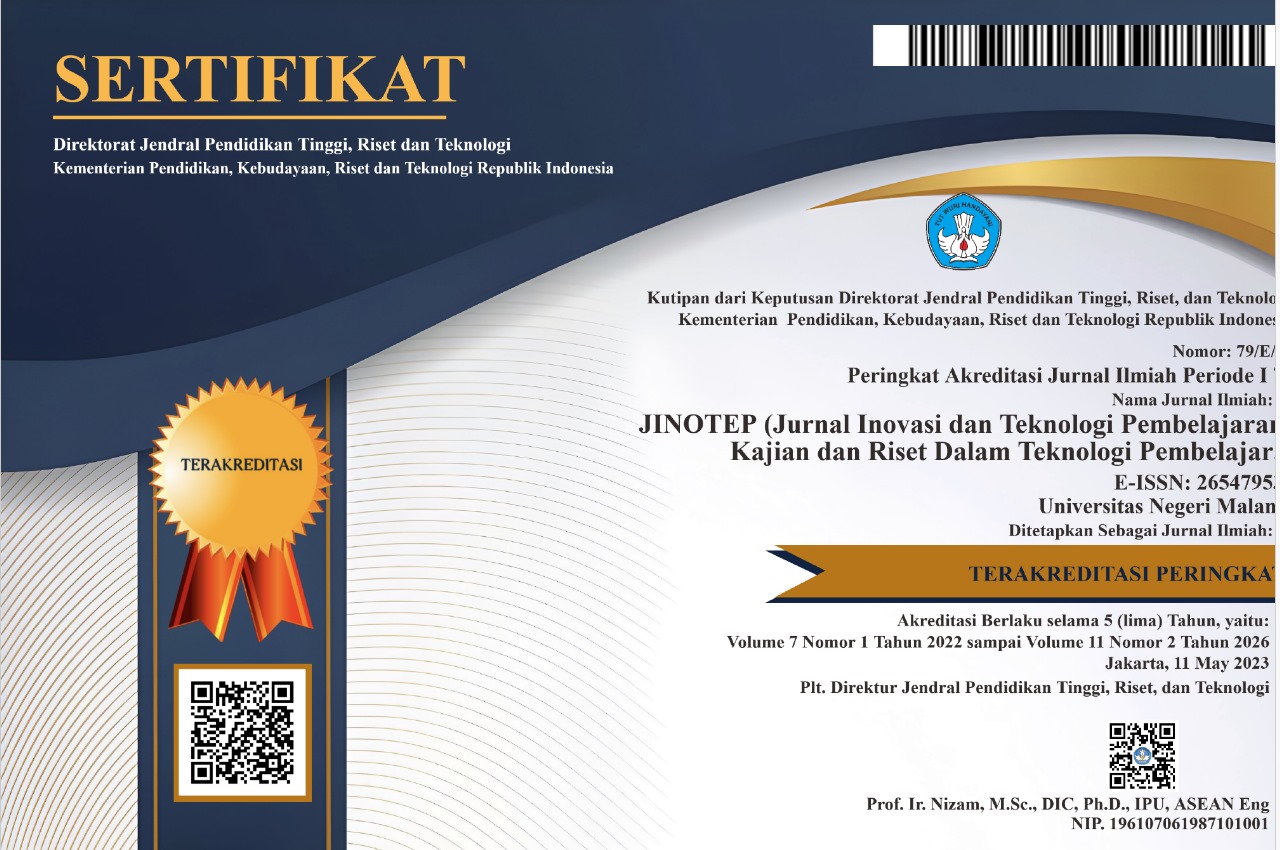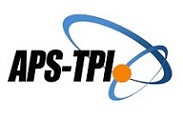Kajian Literatur Sistematis Blended Learning dalam Meningkatkan Motivasi dan Hasil Belajar Siswa SMK
Abstract
Abstrak: Covid-19 memberikan pengaruh kepada berbagai sektor salah satunya pendidikan. Proses perubahan model pembelajaran dari face to face menjadi daring dan luring maupun kombinasi yang dapat memberikan pengaruh. Siswa mengeluhkan kurangnya interaksi bersama guru sehingga kehilangan motivasi belajar yang dapat menurunkan hasil belajar sehingga perlu alternatif pemecahan masalah tersebut. Karenanya, peneliti meneliti mengenai bagaimana penerapan model blended learning pada siswa SMK serta pengaruhnya menggunakan berbagai media e learning terhadap motivasi dan hasil belajar menggunakan metode penelitian kajian literatur sistematis agar nantinya sebagai pertimbangan pelaksanaan blended learning di masa covid 19. Kesimpulannya, model blended learning menggunakan media online e learning Edmodo, LMS Moodle, maupun Google Classroom menghasilkan hasil yang sama yaitu dapat meningkatkan motivasi dan hasil belajar siswa. Namun, google classroom lebih direkomendasikan.
Abstract: Covid-19 has had an impact on various sectors, one of which is education. The process of changing the learning model from face to face to online and offline as well as a combination that can have an impact. Students complain about the lack of interaction with the teacher so that they lose motivation to learn which can reduce learning outcomes so that alternative solutions are needed. Therefore, researchers examined how the application of the blended learning model to vocational students and the effect of using various e-learning media on motivation and learning outcomes using a systematic literature review research method would be used as a consideration for the implementation of blended learning during the covid 19 periods. In conclusion, the blended learning model uses media online e-learning Edmodo, LMS Moodle, and Google Classroom produced the same results, namely increasing student motivation and learning outcomes. However, Google Classroom is more recommended.
Keywords
Full Text:
PDFReferences
Achmadi, T. A. (2015). Pengaruh Penerapan Blended Learning Terhadap Prestasi Belajar Siswa Kelas Xi Jurusan Teknik Pemesinan. Jurnal Pendidikan Teknik Mesin, 3(15), 295–302. http://journal.student.uny.ac.id/ojs/ojs/ojs/index.php/mesin/article/view/3294/2990
Daryanto. (2009). Panduan Proses Pembelajaran Kreatif & Inovatif. Jakarta: AV Publisher.
Emda, A. (2018). Kedudukan Motivasi Belajar Siswa Dalam Pembelajaran. Lantanida Journal, 5(2), 172. https://doi.org/10.22373/lj.v5i2.2838
Gikas, J., & Grant, M. M. (2013). Mobile computing devices in higher education: Student perspectives on learning with cellphones, smartphones & social media. Internet and Higher Education, 19, 18–26. https://doi.org/10.1016/j.iheduc.2013.06.002
Hanum, N. S. (2013). Keefetifan e-learning sebagai media pembelajaran (studi evaluasi model pembelajaran e-learning SMK Telkom Sandhy Putra Purwokerto). Jurnal Pendidikan Vokasi, 3(1), 90–102. https://doi.org/10.21831/jpv.v3i1.1584
Hijazi, D. A., & AlNatour, A. S. (2020). The effect of using blended learning method on students’ achievement in english and their motivation towards learning it: Blended learning, achievement, and motivation. International Journal of Virtual and Personal Learning Environments, 10(2), 83–96. https://doi.org/10.4018/IJVPLE.2020070106
Islam, S., Baharun, H., Muali, C., Ghufron, M. I., Bali, M. E. I., Wijaya, M., & Marzuki, I. (2018). To Boost Students’ Motivation and Achievement through Blended Learning. Journal of Physics: Conference Series, 1114(1). https://doi.org/10.1088/1742-6596/1114/1/012046
Kaur, M. (2013). Blended Learning - Its Challenges and Future. Procedia - Social and Behavioral Sciences, 93, 612–617. https://doi.org/10.1016/j.sbspro.2013.09.248
Kazu, I. Y., & Demirkol, M. (2014). Effect of Blended Learning Environment Model on High School Students’ Academic Achievement. Turkish Online Journal of Educational Technology - TOJET, 13(1), 78–87. https://files.eric.ed.gov/fulltext/EJ1018177.pdf
Keshavarz, M. H., & Hulus, A. (2019). The Effect of Students’ Personality and Learning Styles on Their Motivation for Using Blended Learning. Advances in Language and Literary Studies, 10(6), 78. https://doi.org/10.7575/aiac.alls.v.10n.6p.78
Kholifah, N., Sudira, P., Rachmadtullah, R., Nurtanto, M., & Suyitno, S. (2020). The effectiveness of using blended learning models against vocational education student learning motivation. International Journal of Advanced Trends in Computer Science and Engineering, 9(5), 7964–7968. https://doi.org/10.30534/ijatcse/2020/151952020
Kristina, E., Pandiangan, P., & Layang, S. (2020). Application Of Google Classroom Based Blended Learning Model In Creative Product and Entreprenueurship Learning Subjects In SMK Negeri Penerapan Model Blended Learning Berbasis Google Classroom Pada Mata Pelajaran Produk Kreatif dan Kewirausahaan di SMK N. 8(2), 81–85. https://e-journal.upr.ac.id/index.php/JBL/article/view/2008/1781
Kurniawati, R., & Djuniadi. (2015). Pengembangan Media Blended Learning Berbasis Edmodo di Sekolah Menengah Kejuruan. Indonesian Journal of Curriculum and Educational Technology Studies, 3(2), 16–24. https://doi.org/10.15294/ijcets.v3i2.10924
Lalima, D., & Lata Dangwal, K. (2017). Blended Learning: An Innovative Approach. Universal Journal of Educational Research, 5(1), 129–136. https://doi.org/10.13189/ujer.2017.050116
Maarop, A. H., & Embi, M. A. (2016). Implementation of Blended Learning in Higher Learning Institutions: A Review of Literature. International Education Studies, 9(3), 41. https://doi.org/10.5539/ies.v9n3p41
Osman, N., & Hamzah, M. I. (2020). Impact of implementing blended learning on students’ interest and motivation. Universal Journal of Educational Research, 8(4), 1483–1490. https://doi.org/10.13189/ujer.2020.080442
Priono, A. I., Purnawan, P., & Komaro, M. (2019). Pengaruh Penerapan Model Pembelajaran Blended Learning Terhadap Hasil Belajar Menggambar 2 Dimensi Menggunakan Computer Aided Design. Journal of Mechanical Engineering Education, 5(2), 129. https://doi.org/10.17509/jmee.v5i2.15179
Rafiola, R. H., Setyosari, P., Radjah, C. L., & Ramli, M. (2020). The effect of learning motivation, self-efficacy, and blended learning on students’ achievement in the industrial revolution 4.0. International Journal of Emerging Technologies in Learning, 15(8), 71–82. https://doi.org/10.3991/ijet.v15i08.12525
Rahman, Z., Rijanto, T., & Sumbawati, M. S. (2020). the Implementation of Blended Learning Model Based on Edmodo To Improve Students’ Learning Motivation and Achievement. Jurnal Pendidikan Akuntansi Indonesia, 2(9), 767–775. https://doi.org/10.21831/jpai.v14i1.11371
Rizkiyah, A. (2013). Penerapan Blended Learning untuk Meningkatkan Hasil Belajar Siswa pada Mata Pelajaran Ilmu Bangunan di Kelas X TGB SMK Negeri 7 Surabaya. Jurnal Kajian Pendidikan Teknik Bangunan, 1(1), 40–49. https://jurnalmahasiswa.unesa.ac.id/index.php/jurnal-kajian-ptb/article/view/10264/10031
Rofiqoh, J., Sucipto, T. L. A., & Basori, B. (2020). Pengaruh Blended Learning Menggunakan Think Pair Share Berbantuan Google Classroom Dengan Traditional Learning Terhadap Hasil Belajar Dan Motivasi Belajar Siswa. Jurnal Ilmiah Pendidikan Teknik Dan Kejuruan, 13(1), 11. https://doi.org/10.20961/jiptek.v13i1.22368
Rother, E. T. (2007). Systematic literature review X narrative review. ACTA Paulista de Enfermagem, 20(2), 7–8. https://doi.org/10.1590/s0103-21002007000200001
Schunk, D., Meece, J., & Pintrich, P. (2014). Motivation in Education Theory, Research and Applications. In England: Pearson Education Limited (Fourth Edi).
Setiawan, A., Putra, D. R., Sujalwo, S., & Cahyo, A. N. (2020). Development of Moodle-based Learning Media using Blended Learning Methods in Graphic Design Subject. IJID (International Journal on Informatics for Development), 8(2), 52. https://doi.org/10.14421/ijid.2019.08201
Shamsuddin, N., & Kaur, J. (2020). Students’ learning style and its effect on blended learning, does it matter? International Journal of Evaluation and Research in Education, 9(1), 195–202. https://doi.org/10.11591/ijere.v9i1.20422
Sihabudin. (2018). Pengaruh Strategi Blended Learning Terhadap Hasil Belajar Mata Kuliah Sejarah Pendidikan Islam Pada Mahasiswa Yang Memiliki Locus of Control Berbeda. JINOTEP (Jurnal Inovasi Dan Teknologi Pembelajaran) Kajian Dan Riset Dalam Teknologi Pembelajaran, 3(1), 72–89. https://doi.org/10.17977/um031v3i12016p072
Siyamta. (2017). Strategi Blended Learning Flex Model Pada Pembelajaran Administrasi Jaringan Komputer Untuk Meningkatkan Pengalaman Belajar. JINOTEP (Jurnal Inovasi Dan Teknologi Pembelajaran) Kajian Dan Riset Dalam Teknologi Pembelajaran, 3(2), 122–130. http://journal2.um.ac.id/index.php/jinotep/article/view/2379/1431
Sjukur, S. B. (2013). Pengaruh blended learning terhadap motivasi belajar dan hasil belajar siswa di tingkat SMK. Jurnal Pendidikan Vokasi, 2(3), 368–378. https://doi.org/10.21831/jpv.v2i3.1043
Sudjana, Nana. (2010). Dasar-Dasar Proses Belajar Mengajar. Bandung: Sinar Baru Algensindo.
Syafii, A., Raja, P., & Ari, N. (2016). Blended Learning to Enhance Students’ Motivation in Vocational School. Unila Journal English Teaching, 5(2), 1–11. http://jurnal.fkip.unila.ac.id/index.php/123/article/view/11571/8236
Syarif, I. (2013). Pengaruh model blended learning terhadap motivasi dan prestasi belajar siswa SMK. Jurnal Pendidikan Vokasi, 2(2), 234–249. https://doi.org/10.21831/jpv.v2i2.1034
Utami, I. S. (2018). The Effectiveness of Blended Learning as an Instructional Model in Vocational High School. Journal of Educational Science and Technology (EST), 4(1), 74. https://doi.org/10.26858/est.v4i1.4977
DOI: http://dx.doi.org/10.17977/um031v8i22021p178
Refbacks
- There are currently no refbacks.
Copyright (c) 2021 Yuanita Aritantia, Supari Muslim, Theodorus Wiyanto Wibowo, Tri Rijanto, Mochamad Cholik

This work is licensed under a Creative Commons Attribution-ShareAlike 4.0 International License.
======================================================================
Jurnal Inovasi dan Teknologi Pembelajaran published by Universitas Negeri Malang in collaboration with the Asosiasi Program Studi Teknologi Pendidikan Indonesia (APS TPI) and Ikatan Profesi Teknologi Pendidikan Indonesia (IPTPI) with a MoU.
Publisher Address:
Educational Technology Laboratorium, Building D5, 1st Floor
Faculty of Education, Universitas Negeri Malang
Semarang St. No. 5, Malang City, East Java Province, Postal Code 65145
Email: jinotep.fip@um.ac.id
======================================================================

JINOTEP is licensed under a Creative Commons Attribution-ShareAlike 4.0 International License.
JINOTEP Statistics (Since July 13th, 2020)



.png)




.png)
1.png)
1.png)
4.png)
2.png)
1.png)
1.png)
.png)


_3.png)





1.png)
.png)